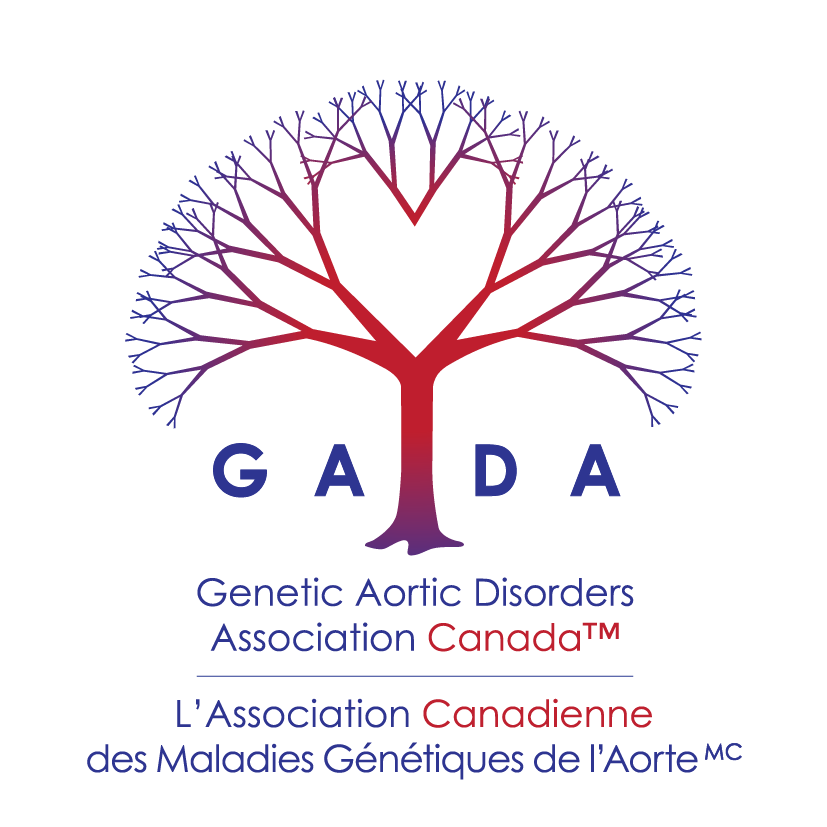At 29 years of age, I was contacted by my birth father (I was adopted at birth) to inform me that I had a 50/50 chance of having inherited a possible genetic mutation. He, his mother, and brother had an aortic dissection or aneurism. Everyone survived. They were working with a geneticist in Ontario and were all part of a study out of Texas. I also contributed a DNA sample to the study.
At the time, the gene causing the mutation had not yet been identified. He communicated that most doctors would likely label it Marfan syndrome but it was better described as TAAD because it specifically affected only the aorta.
I began seeing a cardiologist who monitored me with echocardiogram twice a year. When I got pregnant in 2011, I was monitored as a high risk pregnancy and had regular echocardiograms.
I had a very smooth, healthy pregnancy until at 33 weeks, while stretching at home I got a strange, sudden pain in my throat. I didn’t feel well and it persisted through the night. The following morning we went to the ER. My vitals were all normal. I was sent home, diagnosed with a cold. The pain subsided and I carried on, thinking nothing of it. In retrospect, I believe that was the first symptom of an aortic dissection. Just over a week later, while walking our dog I got a sudden and sharp pain in my back. I called my cardiologist and they suggested I should be seen at the ER and scheduled a follow up echo the next week. At the ER, the pain in my back grew excruciating. They gave me a strong painkiller. I explained my risks but the doctors hesitated to do an MRI because of the baby. They did an ultrasound of my stomach and found a few gallstones. The doctor felt that the gallstones along with heartburn (common in pregnancy) were the source of my pain and I was discharged. I had a very painful weekend spent mostly in the bath because floating in water seemed to help the pain in my back. Early the following week, I went to the cardiologists as scheduled for the follow up echo. Here the technician spotted that my ascending aorta had dissected. It was at approx. 6 cm, the standard size being closer to 3.5 cm.
From there I was sent for surgery, I’m pretty sure nothing gets you to the front of the line faster than telling them you’re 35 weeks pregnant with an aortic dissection. I had an MRI to confirm the status of the dissection before making decisions on how best to proceed; with the repair of the dissection first followed by delivery of my baby or the other way.
The way I understood it, there was very little chance our child would survive the surgery and first removing her by C-section could mean excessive bleeding in which case a hysterectomy might be necessary in order to stop my uterus from bleeding excessively. In the end it was our decision; did we want to risk jeopardizing my heart surgery in order to deliver our baby? Daniel and I didn’t take long to decide, our baby girl was coming out that day. If anything, we felt that leaving her in me seemed riskier and I think it’s the smartest decision we’ve ever made. I can’t imagine recovering from the surgery still pregnant!! What I remember next is being woken up by Daniel and my nurse. They were hanging images of our baby girl, Nina.
Given my circumstances and no previous case to refer to, the doctors did what they could to save my life. It has been 4 years since my surgery and I remain stable. I am monitored closely with an echo and an MRI once a year. I take blood pressure lowering meds as a precaution. It took a while to come to myself but most of the time I feel great. I experienced some numbing throughout my body for the first few years.
Since my episode, the genetic mutation has been identified as the MYH11 gene. We have been able to test our daughter Nina and are so happy to share that she does not carry the mutation!
I am happy that I am alive and thankful to the team of doctors and nurses at the hospital. Obviously, there was some misdiagnosis for the first few weeks. I think it’s crucial to work together with the medical community to better identify cases like mine. The medical and lay community needs an organization such as GADA Canada to promote knowledge of such rare genetic disorders and provide support to Canadians facing the precariousness of these disorders. GADA’s programs to support research give us hope for a much secure future.
